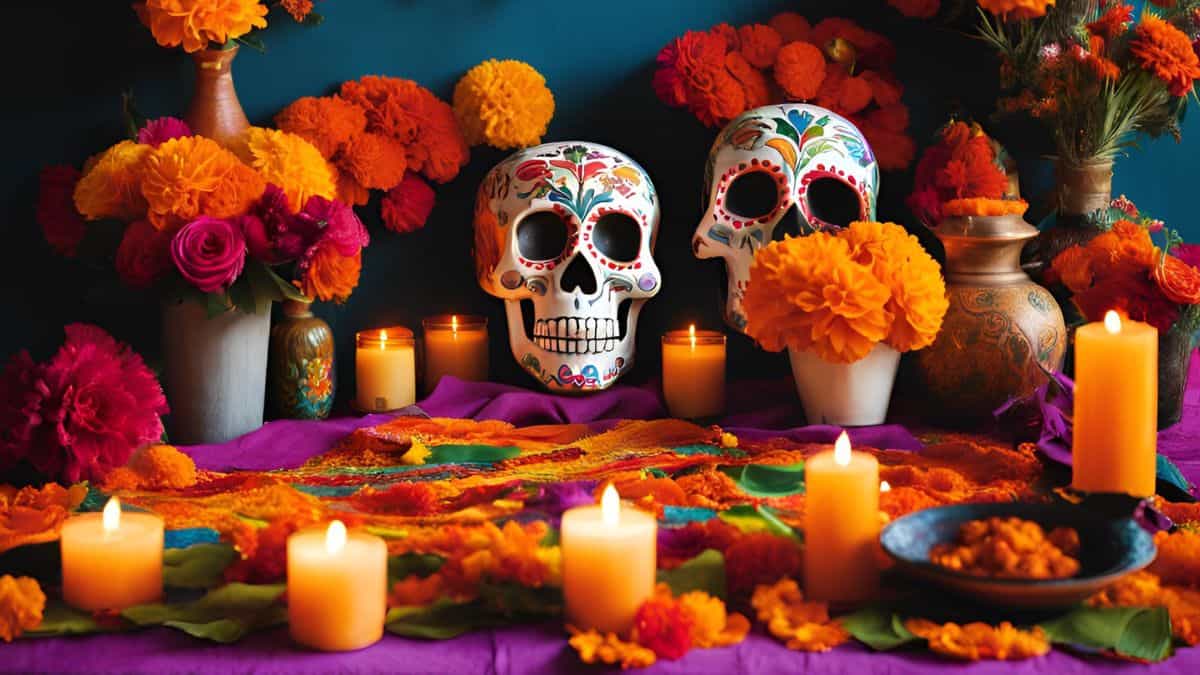
The Day of the Dead is one of Mexico’s most iconic traditions, recognized worldwide for its vibrant colors, symbolism, and the spiritual connection it establishes between the living and the dead.
Although this celebration, as we know it today, is the result of the blending of pre-Hispanic cultures and Catholicism, it has deep roots in Mexico’s indigenous past.
What were the altars of the dead like in pre-Hispanic times?
The altars set up during the Day of the Dead today are not exactly the same as those used in pre-Hispanic times.
Before the arrival of the Spanish and the resulting cultural and religious blending, the ancient Mexicans did not celebrate the Day of the Dead in the way we do today. Instead of altars decorated with candles, marigold flowers (cempasuchil), and photographs, indigenous peoples performed death-related rituals that included offerings to guide the deceased on their journey to the underworld.
In Mesoamerican cultures, death was not seen as the end of life, but as a process of transformation. The dead did not “return” in the way we believe today, but they were honored through ceremonies that involved offerings of food, tools, and objects to help them on their journey to Mictlán, the underworld.
The offerings were placed in tombs or sacred sites, not necessarily on altars as we know them now, but always with deep respect for the spirits of the deceased.
ALSO READ. Day of Dead: 10 facts about Dia de los Muertos
Since when has the Day of the Dead been celebrated?
The celebration of the Day of the Dead in its current form began to take shape with the arrival of Spanish colonizers in the 16th century. The pre-Hispanic rituals, centered on the worship of death, merged with the Catholic practices of All Saints’ Day and All Souls’ Day, giving rise to what is now one of Mexico’s most representative celebrations.
Although the contemporary celebration is the result of this syncretism, the ancient Mesoamerican peoples already dedicated rituals and festivals to death.
For example, the Mexica performed ceremonies in honor of death and the dead throughout the year, but the most prominent took place in August and November, which coincided with the harvest and the end of the agricultural cycle. These festivities were dedicated to Mictlantecuhtli, the god of death, and his consort Mictecacíhuatl, the goddess of the dead, who ruled over Mictlán, the underworld.
ALSO READ. Día de los Muertos: What day is Day of the Dead for Cats?
How was the Day of the Dead celebrated in pre-Hispanic times? The Mictlán
For the Mexica, one of the most influential cultures of Mesoamerica, death was seen as the beginning of a long journey to Mictlán, the kingdom of the dead or underworld. This journey was not easy: the souls of the deceased had to traverse a difficult path that lasted four years to reach their final destination.
The Aztec myth describes how, upon dying, the body of the deceased was devoured by Tlaltecuhtli, the goddess of the earth. However, this goddess also had the power to “birth” souls, which began their journey to Mictlán after being freed from the body. This process symbolized the cycle of life and death: the earth consumes bodies but also gives life to souls.
During the journey, souls faced a series of challenges until they reached Mictlantecuhtli and Mictecacíhuatl, the rulers of Mictlán. Once there, the dead would find eternal rest, depending on how they had died. Souls that died honorably, such as warriors or women who died in childbirth, did not make this journey to Mictlán but instead went to other higher destinations.
ALSO READ. Día de los Muertos. Key facts about the pre-Hispanic origin of the Day of the Dead
The blending and creation of the modern Day of the Dead
With the arrival of the Spanish and the imposition of Christianity, indigenous beliefs about death merged with Catholic festivities. All Saints’ Day (November 1st) and All Souls’ Day (November 2nd) were integrated with pre-Hispanic rituals to create the modern Day of the Dead.
During this process of syncretism, many pre-Hispanic elements were preserved, though adapted to the new Catholic religion. The altars we know today, for example, are a mix of both worlds: they maintain the tradition of offering food, drinks, and other objects for the dead but include Christian elements like crucifixes, images of saints, and candles symbolizing divine light.
Elements of altars
Although modern altars have evolved over time, many of their elements are rooted in pre-Hispanic beliefs. Some of the most common offerings placed to honor the deceased in pre-Hispanic times were:
- Food and drink: To nourish and strengthen the spirits during their journey to the underworld.
- Instruments and tools: It was believed that the deceased would need everyday objects on their journey to Mictlán.
- Flowers and copal: These offerings were meant to purify the environment and guide the dead with their scents.
- Sacrificed animals: In some cultures, animal sacrifices accompanied the offerings as a form of honor and tribute to the gods.
The legacy of pre-Hispanic altars today
Today, the Day of the Dead is a celebration that has transcended borders and is part of the Intangible Cultural Heritage of Humanity, according to UNESCO. Although the altars placed during this celebration are not identical to those used by the ancient Mexicans, they do preserve their essence: the respect and veneration for the dead. The blending of indigenous and Catholic beliefs has given rise to one of the richest and most unique traditions in the world, where life and death are celebrated in a colorful and festive way.
Thus, every November 1st and 2nd, millions of Mexicans set up their altars, decorated with marigold flowers, candles, papel picado, and the favorite foods of their loved ones, to remember that death is not the end, but a continuation of life in the world of spirits.










